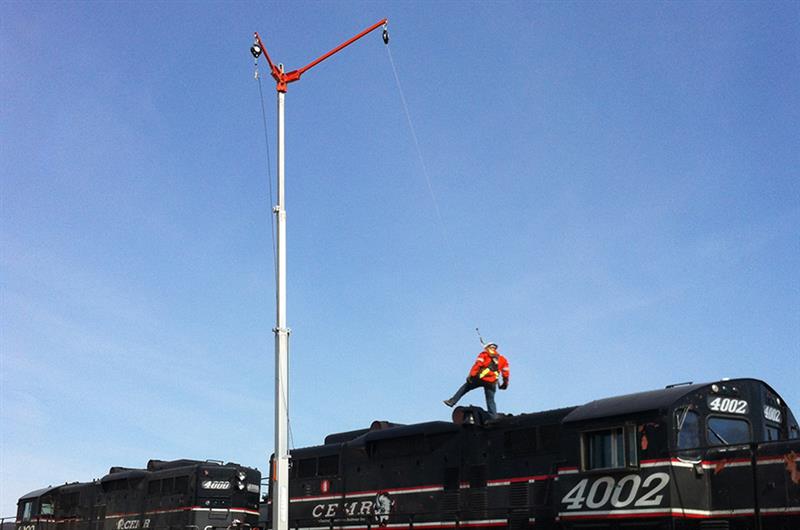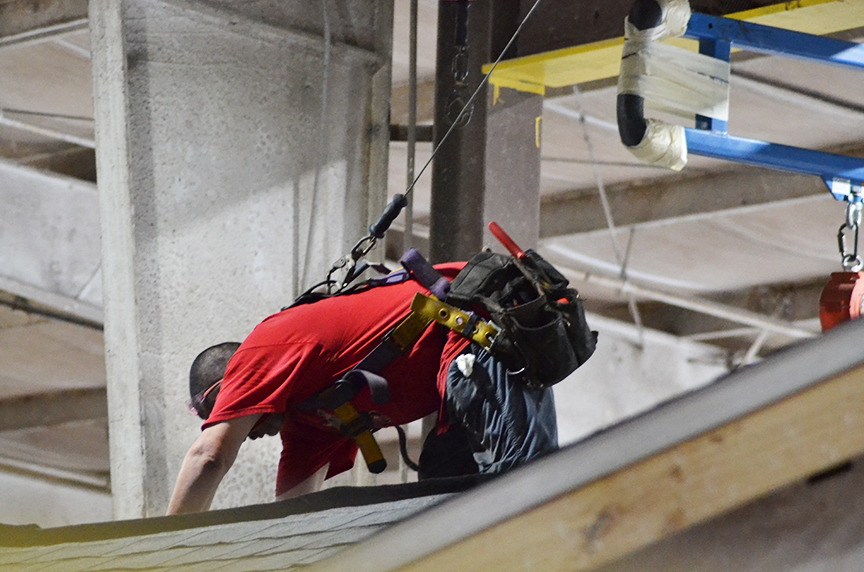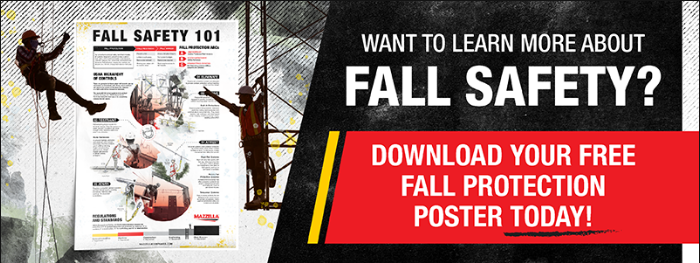A Dictionary of Fall Protection Terms
Learn the most common fall protection terms and definitions used in OSHA and ANSI standards. Use this dictionary to train workers, improve safety, and ensure compliance when working at height.
Whether you’re training a new worker, brushing up on safety standards, or reviewing your company’s fall protection program, understanding the language of fall protection is essential.
OSHA, ANSI, and equipment manufacturers all use specific terminology to describe systems, components, and procedures that keep workers safe at height.
A clear understanding of these terms helps ensure compliance, improves communication between crews and safety managers, and reduces the risk of accidents. This dictionary brings together the most common fall protection terms used in OSHA’s 1910 (General Industry) and 1926 (Construction) standards, along with the terms you’ll encounter on job sites and in safety training.
Use this guide as a reference for toolbox talks, training sessions, and daily operations to help your team speak the same language when it comes to working safely at height.
Fall Protection Terms and Definitions
| Term | Definition |
| 1910 | OSHA standard for fall protection requirements in general industry. |
| 1926 | OSHA standard for fall protection requirements in the construction industry. |
| 3-Way Retractable (Rescue & Retrieval SRL) | A self-retracting lifeline designed for both fall arrest and rescue/retrieval operations. Common in confined space and rescue systems. |
| Adjustable Length Lanyard | A lanyard with adjustable length, typically between 4–6 ft, used to prevent workers from reaching a fall hazard. |
| Anchorage | A secure connection point for a fall protection or rescue system, capable of supporting at least 5,000 lbs per user or as designed by a qualified person. |
| ANSI | The American National Standards Institute, which develops consensus standards such as ANSI/ASSP Z359 for fall protection. |
| Arc Flash PPE | Specialized personal protective equipment designed to protect against high-energy electrical hazards. |
| Arrest Distance | The total vertical distance required to stop a fall, including free fall and deceleration. |
| ASSP | The American Society of Safety Professionals, responsible for managing the ANSI/ASSP Z359 standard series. |
| Bosun’s Chair | A seat device used to suspend a worker from a rope to perform work aloft. |
| Bungee Lanyard | An elasticized lanyard that stretches to minimize trip hazards and reduce shock forces during fall arrest. |
| Butterfly Anchor | A hinged temporary roof anchor designed for single-user fall protection. |
| Class 1 SRL | A self-retracting lifeline rated for overhead tie-off only. |
| Class 2 SRL | A self-retracting lifeline that can be used for overhead or below the D-ring tie-off (e.g., foot-level applications). |
| Competent Person | A worker designated by the employer who can identify fall hazards, correct them, and perform system inspections. |
| Confined Space | An area large enough for entry but not designed for continuous occupancy, with limited access or egress. |
| Connector | A device (like a carabiner or snap hook) that links the harness to an anchorage or lifeline. |
| Controlled Descent | A method that allows a worker to lower themselves at a regulated speed and stop safely at any point. |
| D-Ring | A D-shaped metal connector commonly found on harnesses for attaching to fall arrest systems. |
| Energy Absorber | A device or component that dissipates kinetic energy to reduce the arresting force on a worker during a fall. |
| Fall Arrest | A system designed to stop a worker’s fall after it occurs. |
| Fall Restraint | A system that prevents a worker from reaching a fall hazard. |
| Fixed-Length Lanyard | A non-adjustable lanyard with a set length, typically used for fall restraint. |
| Foot-Level Tie-Off | An anchorage point located below the worker’s D-ring, requiring special Class 2 SRLs for safe use. |
| Free Fall Distance | The vertical distance a worker falls before the fall arrest system engages. |
| Guardrail | A physical barrier designed to prevent falls to lower levels. |
| Horizontal Lifeline (HLL) | A flexible cable system installed horizontally between two anchorages to allow movement at height. |
| Hot Work PPE | Protective gear for welding, grinding, or cutting—tasks that produce heat or sparks. |
| Leading Edge | An unprotected edge on a working surface that presents a fall hazard; requires special SRL equipment. |
| Lollipop Anchor | A removable concrete anchor used to create secure temporary anchorage in structural concrete. |
| PFAS (Personal Fall Arrest System) | A complete system of anchorage, connectors, and a full-body harness designed to arrest a worker’s fall. |
| Qualified Person | An engineer or experienced professional who designs and approves fall protection systems. |
| Rescue Plan | A written procedure to ensure the prompt retrieval and care of a fallen worker. |
| Rigid Rail System | An overhead trolley and track system (such as SPANCO or Gorbel) that provides controlled fall arrest with minimal clearance requirements. |
| Rope Grab | A device that travels along a vertical lifeline and locks automatically in the event of a fall. |
| Safety Net | A mesh net installed below work areas to catch falling workers or debris. |
| Shock-Absorbing Lanyard | A lanyard that reduces impact force by stretching or deploying an internal shock pack during a fall. |
| SRL / SRD (Self-Retracting Lifeline or Device) | A device with a retractable line that automatically locks during a fall to arrest descent and limit fall forces. |
| Suspension Trauma | A life-threatening condition caused by restricted blood flow when suspended motionless in a harness after a fall. Can begin in as little as five minutes. |
| Swing Fall | A pendulum effect that occurs when a worker falls while anchored to a point that is not directly overhead. |
| Total Fall Distance | The total distance a worker travels during a fall, including free fall, deceleration, and harness stretch. |
| Vertical Lifeline (VLL) | A lifeline system that runs vertically to protect workers climbing or descending ladders or towers. |
| Warning Line | A flagged line used to warn workers of an unprotected edge, often on flat or low-slope roofs. |
| Winch | A mechanical device used for controlled raising or lowering, common in confined space rescue operations. |
| Yo-Yo | Informal term for a self-retracting lifeline (SRL). |
Why Fall Protection Terminology Matters

A misunderstanding between “fall restraint” and “fall arrest,” or between a “competent person” and a “qualified person,” can lead to serious injuries or violations.
OSHA requires that all workers using fall protection systems are trained to recognize hazards and understand how their equipment works. Understanding these definitions helps ensure inspections are performed correctly, fall hazards are mitigated, and rescue plans are in place before work begins.
For example:
- Inspections must be conducted by a competent person at least annually and by the user before each use.
- Rescue planning is required under OSHA 1910.140(c)(21), ensuring a fallen worker can be retrieved quickly and safely.
- Fall clearance calculations must account for total fall distance, swing fall, and deceleration.
When every team member understands these terms, everyone is better equipped to make safe decisions at height.
How Can You Improve Your Company’s Fall Protection Practices?

Understanding fall protection terms is a great step to improving working at height practices. But what else can you do? Here are some good places to start:
Inspect Your Fall Protection Systems
OSHA’s standards are very clear when it comes to inspection requirements.
Fall protection equipment must be inspected before each use by the person wearing it. This is outlined in 29 CFR 1910.140 and 1926.502(d)(21). In addition to these daily inspections, OSHA also requires periodic evaluations by a competent person. These more formal inspections must occur at least once a year, or more frequently depending on the environment or manufacturer’s recommendation.
Train Workers on Fall Protection Best Practices
Lives are on the line every day when working at height on job sites, or in manufacturing and industrial facilities, which is why it is critical that your team receive the fall protection training that is required by OSHA.
Invest in Engineered Fall Protection Systems
While a new engineered fall protection system can cost more money and present unique engineering challenges, the payoff of avoiding workplace injuries and fatalities and meeting stringent industry standards is all the reason to invest in them.
Frequently Asked Questions About Fall Protection (FAQ)
Copyright 2025. Mazzella Companies.

